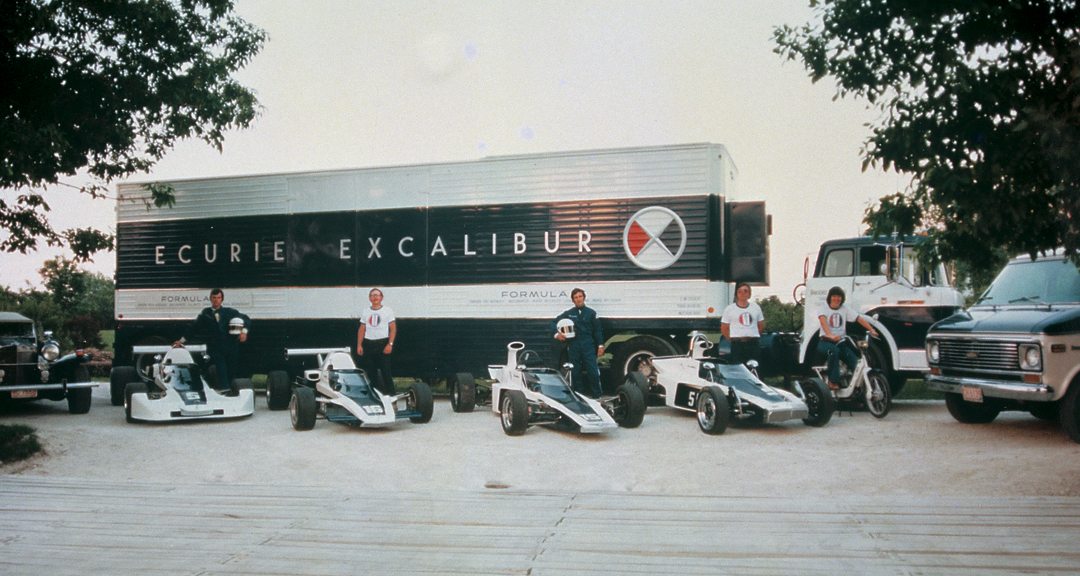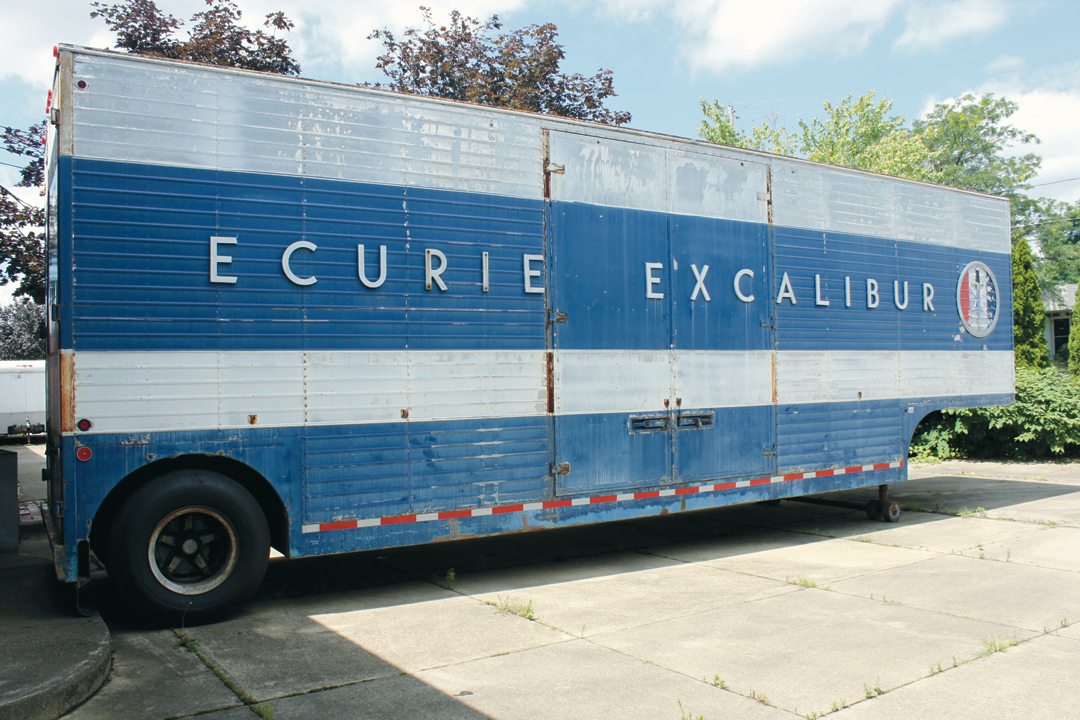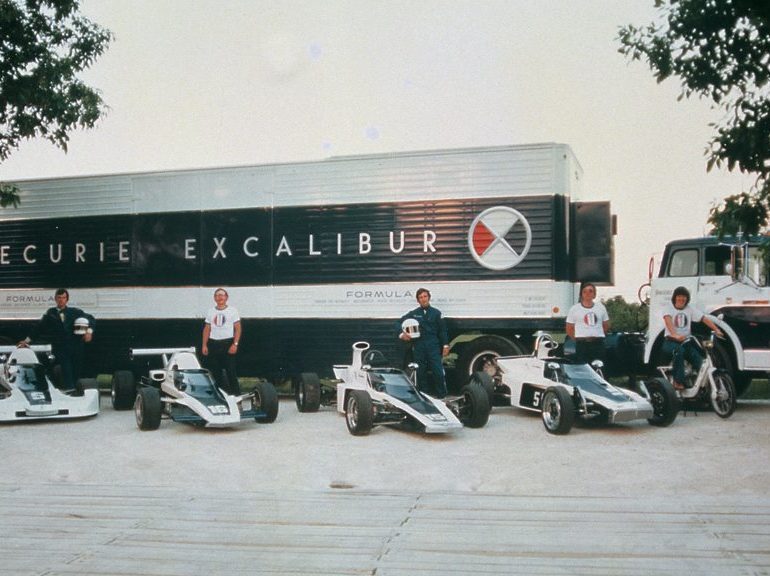Brooks Stevens Trailmobile Transporter
If you’re involved in any facet of the car hobby and have never heard of Brooks Stevens, you should probably take up golf. Stevens was an iconic American industrial designer whose career spanned 60 years. He studied architecture at Cornell University. In 1944, Stevens, Raymond Loewy and several other colleagues founded the Industrial Designers Society of America. Stevens’ interests ran the gamut and he generated thousands of designs for domestic and industrial applications. It was Stevens who gave us the wide-mouthed peanut butter jar, the “see inside” window on the front of the clothes dryer, as well as the beloved Oscar Mayer Wienermobile. By the early ’50s it’s estimated that the sale of Stevens’ gizmos, gadgets and designs were responsible for more than one billion dollars in revenue.
And, of course, Stevens penned and collaborated on several groundbreaking vehicles including: tractors for Allis-Chalmers beginning in 1937; 1940 Johnson Wax Research Vehicle; 1945 custom for Diana Lewis Powell; 1946 Willys-Overland Jeep Station Wagon; motorcycles for Harley-Davidson in 1948; 1948 Willys-Overland Jeepster Phaeton; 1949 Cleveland Welding Roadmaster bicycle; 1951 Kaiser-Frazer “Frazer” Sedan; the 1953 Paxton automobile; the 1952 Excalibur J racecar; 1954 Die Valkyrie Coupe; 1955 Gaylord Grand Prix; 1956 Willys Forward Control Commuter; 1956 AMF Trike; 1959 Olin Mathiesson Scimitar town car; 1960 Jeep Harlequin Prototype; 1961 Studebaker Gran Turismo Hawk; 1962 Excalibur Hawk racecar; 1963 Jeep Wagoneer; 1964 Series I Excalibur SSK Roadster; 1968 AMX-R Prototype; 1969 Sears Screamer bicycle.
Stevens’ passion for design led to his own collection and a museum in Mequon, Wisconsin. One day in 1963, Stevens was visiting the museum’s repair shop and noticed a job applicant for a mechanic’s position under the hood of a car. The applicant was adjusting valves as a test to show their level of skill. Stevens pointed to the applicant and said to the manager who ran the shop and Mr. Stevens’ collection, “If he’s going to work here, he’s going to need a haircut.” That “he” applicant turned out to be Alice Preston who was hired on the spot, and over the next 32 years came to be one of Stevens’ closest friends. It turns out that Stevens had a thing for Alices. Alice #1 was his wife Alice Kopmeier. Alice #2 was Alice Preston. And Alice #3 was his secretary, Alice Brock.
In 1960, Stevens bought a brand-new Trailmobile trailer to go racing with the Excalibur J cars and Go Karts. The trailer was heavily modified and was decked out in typical Brooks Stevens fashion. According to Preston, “The transporter was the first of its kind in the Midwest, and was really something special. There was a machine shop, a lounge and even sleeping bunks that folded down from the walls. We did most of the work at our factory. There was a railing up top that folded down and we had stairs fabricated that went up to the roof for Brooks. There was also an awning, but I can’t remember who did that work for us. There was always a large entourage of family, friends and children, with the transporter acting as the center of all activities. Those were some great times. At first we raced the Excalibur J cars out of that transporter. Hal Ulrich was one of our drivers. Later we raced Formula Vees and Formula Fords and Atlantics. Mr. Stevens would buy a car and then heavily modify the body to give it his own special touch. One of his sons, David Stevens, was doing a little racing at that time. We also raced Go Karts out of the transporter. The youngest son, Kip, raced the Karts for a short while, but Mrs. Stevens put an end to that as the Karts were capable of more than 100 mph.” According to David Stevens, “The transporter went international in 1961. They were going for the big Go Kart race around Thanksgiving. Brooks rented a barge to take it to Nassau in the Bahamas. They nearly lost it as the barge hit rough seas and was pitching all around.”

Preston started as an assistant mechanic at the museum in 1963. After more than 10 years of service she moved to West Allis (yes that’s #4 of this story), Wisconsin where she worked in the Paint Department at the Stevens’ family Excalibur Automobile Corporation. Later she set up the factory’s machine shop and still later the Research and Development Department with David Stevens. She also ran all of the fabrication departments. Preston says that between 1964 and 1989 a total of 3,268 Excalibur cars were produced. She estimates that an additional 200 cars (an approximation) were built between 1990 and 1996 when production stopped.
In 2001, Preston bought the Excalibur name and all rights with the blessings of the Stevens family. Her company performs restorations on Excalibur cars, supplies parts to owners and enthusiasts, and buys and sells Excalibur cars. She has also been the custodian of the Brooks Stevens Transporter, which she saved from extinction by taking it with her each time she moved. Preston says the transporter was in service at the racetrack from 1960 to 1979. After that, she says, “It sat at the museum and slowly sank into the ground. With help from David, I was able to save it from the scrap yard. The tractor was past saving and was scrapped. Mr. Stevens died on January 4, 1995, and the museum was sold on August 1, 1999. Mr. Stevens put a great deal of himself into that transporter, and in my view it was one of the foremost transporters of its type back in the day. That’s why I’ve always believed it was an important piece of history that should be saved.”
Historic racing transporters are now highly collectible and the Brooks Stevens rig survives largely intact. So does Brooks Stevens’ amazing legacy; a life and career that completely shaped our world in a most positive way.

If all of the above hasn’t made you a Brooks Stevens fan and you’re headed for golf, you should probably know this. In 1974, Stevens designed a Cushman Motors Excalibur Golf Cart with a Rolls Royce front end for Jackie Gleason. “The Great One’s” golf buggy! Wonder where that one’s hiding?




